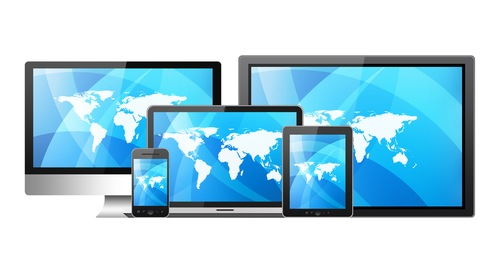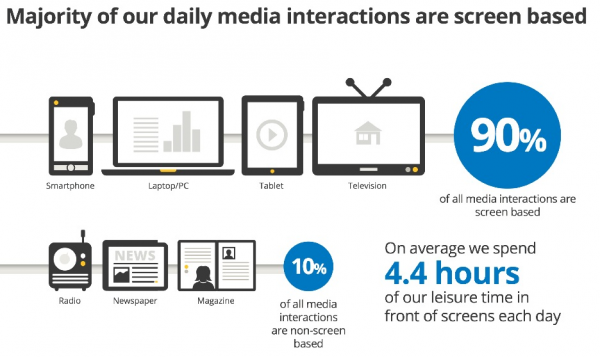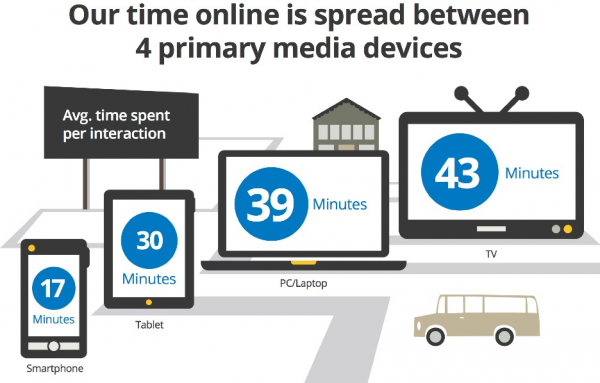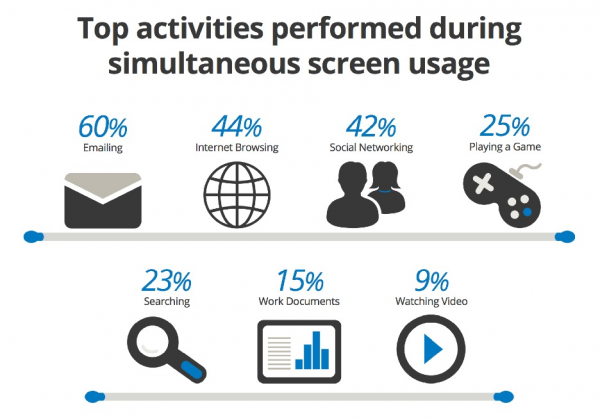We are a nation of multi-taskers. As you read this, you’re either doing something else, or this is the “something else” you’re doing while your work on other projects or relax in front of another device. Not only are we multi-taskers, we’re also multi-screeners. Whether it’s a smartphone, tablet, PC/laptop, TV or something other device, we’re consuming, creating, and curating content across multiple devices, often at the same time. It seems that we’re rewiring our brains simply by how we interact with content and devices as part of our everyday lives.
As we become increasingly wired…or wireless, that leaves room for two types of people in this world, those who are always-on and those who are at least connected. I’ve long maintained that the net result of connectedness is a narrowing attention span. I don’t necessarily believe that attention is as much distracted as it is focused on what’s important in the moment. As such, businesses are simply trying to reach an audience or audience segments, but instead an audience with an audience of audiences that is interconnected by shared interests and experiences.
How you design, sell, market, and serve will require nothing short of complete transformation over the next 10 years. This is true in not only how you engage connected customers but employees as well. It’s a lifestyle and as businesses, we must become connected to earn relevance. If we don’t, then we earn just the opposite, irrelevance. I refer to this transitory economic state as Digital Darwinism, when technology and society evolve faster than the ability to adapt.
So what does this multi-tasking multi-screen audience with an audience of audiences look like you ask? Google recently released a telling report, “The New Multiscreen World” that reveals the extent of cross platform consumer behavior.
The study offers an awakening glimpse into the impact of connected consumerism and how it forces a shift in the future of customer engagement. In short, your customer base is fragmented. Just showing up in new channels and creating website-like presences in social networks isn’t enough. Designing apps or creating digital assets for mobile devices is only part of the solution. Without a vision, without an articulation of the overall experience and how customer engagement takes shape in each channel and as a whole, any work you do may hurt more than it helps.
What does the multi-screen world look like today?
According to Google’s research, 90% of all media interactions are screen based, including smartphones, laptops, tablets, and TVs. On average, consumers spend 4.4 hours of leisure time in front of these screens every day. On the contrast, only 10% of all media interactions are non-screen based. The victims of this attention shift come as no surprise as radio, newspapers, and magazines were threatened long ago.
The four screens are becoming equal in how they lure our attention. In each sitting or interaction, time spent on each device isn’t that far apart.
TV – 43 minutes
PC/Laptop – 39
Tablet – 30
Smartphone – 17
Not only are consumers spending a significant amount of time on these devices outside of work, they’re doing so at the same time. And, as the once king of the living room, the idea of a TV, it too is evolving. Programs, how they’re watched and when, will undergo an significant transformation over the next several years. This will be primarily fueled by content consumption behavior and how Generation-C blurs the lines between the screens. As they become more capable, content will freely traverse devices creating an overlap in the roles they play.
Content Context is King
I’ve long maintained that while content is important, context is truly how we’re digitally seduced. That context may shift from device to device. Google found that as consumers move seamlessly between devices each day, they tend to focus usage of each device based on context as well as…
– The amount of time they have or need
– They goal they want to accomplish
– Their location
– Their attitude and state of mind
Each device serves a particular purpose.
Computers Keep Us Productive and Informed
24% of our daily media interactions occur on a PC
40% use PCs to find information
29% use them to keep up to date
69% of use is at home and 31% out of home
Usage is productive and task-oriented
It requires significant amount of time and focus
The mindset is serious with a research intensive attitude
Smart Phones Keep Us Connected
38% of our daily media interactions occur on a smartphone
60% of this usage is at home and 40% out of home
54% of attention is dedicated to communication and 33% is entertainment
People use smart phones to communicate and connect in short bursts of time. And, they need information quickly and efficiently.
Tablets Keep us Entertained
9% of daily media interactions occur on tablets
79% use tablets at home and 21% out of home
63% of usage is for entertainment purposes and 32% is for communication
Tablets are mostly used for entertainment and browsing
Consumers loose their sense of time as tablets inspire a relaxed and leisurely approach
Sequential vs. Simultaneous Usage
As a nation of multi-taskers and multi-screeners, Google observed two forms of distinct behavior.
Sequential usage follows consumers as they begin their journey on one screen and continue that journey across devices at different times to accomplish a specific task. Think about seeing an idea for a trip on your smart phone and then continuing your research to tablet for research and eventually your PC to book the trip.
90% of consumers use multiple screens sequentially to accomplish a task over time.
The top activities for sequential screening include:
Browsing the internet – 81%
Social networking – 72%
Online shopping – 67%
Research/Search – 63%
Managing Finances – 46%
Planning a trip – 43%
Google’s research found that smartphones are the most common starting places for online activities.
PCs are the source of more complex activity.
Tablets are typically the starting point for shopping and trip planning
Simultaneous usage occurs as the consumer is using more than one device at the same time for either a related or an unrelated activity. Social TV is one of the most common examples of simultaneous multi-screening. While watching TV, consumers will use either a tablet, PC, and/or a smart phone to have conversations on social networks about what’s on the TV or just in general, play games, or look up more information about the show that they’re watching.
On average, Google found that we use three different screen combinations every day.
81% – Smartphone and Television
66% – Smartphone and Laptop/PC
66% – Laptop/PC and Television
How are people using these devices simultaneously and to what extent?
Smartphones: 57% of the time consumers us a smartphone, they’re also using another device. 28% of the time is with a PC/Laptop and 29% is with a TV.
Tablets: 75% of the time tablets are used, it’s done so with a smartphone (35%) and TVs (44%).
TVs: 77% of people who watch TV do so with another device. 49% use a smartphone and 34% watch TV with their laptop.
PCs/Laptops: 67% of those who use their laptop/PC are also using another device.
What are people doing during they’re multi-screening?
They’re doing the things that single screeners often do, but just at the same time…
Email = 60%
Internet browsing = 44%
Social networking = 42%
Playing games = 25%
Searching = 23%
In Summary
Consumers are incredibly connected and their attention can only be described as fragmented as best.. As they multi-task and multi-screen, new touchpoints emerge for engagement. Google refers to these new touch points as “found time.” These micro-moments emerge as consumers see or think of something something and reach for the screen that’s closest to them to search. Google found that consumers use these micro-moments across multiple screens to search, shop, communicate and keep entertained….spontaneously. This offers advertisers net additional opportunities to engage consumers throughout the day in ways that are contextually relevant to each screen.
Here’s what real people have to say about how their new found time helps them:
“I’m online more than before, for sure. I check a lot more stuff every day than I normally would have never done, because it’s so easy to check. I can go to 10 apps, when I have 15 free minutes, I can check my bank account or I can check the news or I can check some music websites that are very cool.” – Leum
“I scan for deals on Groupon or Twitter when I’m waiting in line. It’s life time management. Whether it’s something urgent for business or something fun – I get to choose what to look at.” – Maria
That’s what this is about. Your business must now understand how consumer behavior is splintering away from the customer that you know and creating a new type of customer you need to know.
The future is indeed bright across the screens, but what’s happening now is happening by happenstance. Imagine what this will look like once you start to design experiences around found time and the multi-tasking, multi-screen consumer journey. Beyond understanding, for any this to be optimized and beneficial to your business, takes vision and architecture. You are the architect of new experiences for a new generation of connected consumers.
Connect with me: Twitter | LinkedIn | Facebook | Google+
The End of Business as Usual is officially here…
Originally published on AT&T’s Networking Exchange
Image credit: Shutterstock
The post We are now a society of multi-taskers and multi-screeners appeared first on Brian Solis.




